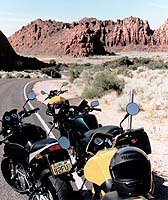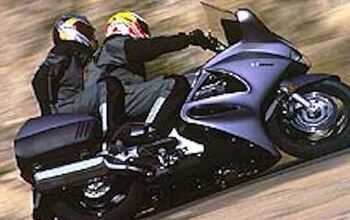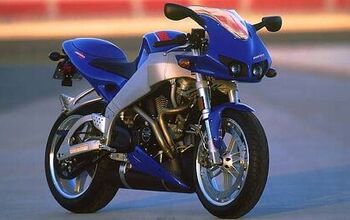Church of MO: 1999 Buell Motorcycles
And Jesus was raised on the third day, according to the Scriptures, but when he emerged from the tomb and saw that people were still using dial-up modems and AOL, and that the MO photos were tiny and that Harley-Davidson had just bought Buell… he said, Y’know what? This is ridiculous. I’m going on back in the crib to sleep a bit longer. Let’s try this resurrection thing again in a few years, mm’kay? And so it is written, far as you know.
1999 Buell Motorcycles
They’d already been ogled, some opinions already had formed, and insightful (or not so) pronouncements already had been delivered by some present with a style approaching iambic pentameter:
Does not this bike with routed airflow seem
A baked right rider’s leg, this sin redeem?
Nevertheless, the bikes looked so good, all glossy and bright, that ‘oohs’ and ‘ahs’ were uttered all over again, and rightfully so. Buell has a lot to crow about.
A new fourth tie rod combined with a new triangular front frame spar increases frame rigidity.
Fuel InjectionNow that Harley owns 98 percent of Buell American Motorcycles, Erik Buell can worry less about running the day-to-day operations of his eponymous company and worry more about tacking state-of-the-art technology onto his sportbikes.
Fuel Injection, now standard issue for the 1999 Thunderbolt S3 and Lightning X1, courtesy of Harley-Davidson’s supplier, VDO Control Systems and Walbro Corporation. Enter fuel. The new dynamic digital fuel injection (DDFI) is a single (non-waste) spark, sequential port fuel injection system, using a throttle body instead of a carburetor, and two fuel injectors mounted in the intake manifold to deliver fuel when signaled by an electronic control module (ECM). The 16-bit microprocessor-based ECM also controls spark advance. As engine load and ambient conditions change, the ECM is supposed to alter spark and fuel delivery independently, controlling individual engine cylinders separately, in order to maximize efficiency and performance.
Buell’s EFI system functions as a closed loop system, relying on EFI maps for idle or wide-open throttle positions, a combination of mapping and feedback from an exhaust gas oxygen sensor and five other sensors for intermediate throttle positions. This is supposed to be more accommodating to a wider variety of riding conditions than an open loop system which relies solely on EFI mapping to set spark and fuel delivery. Does it work? Well, it’s hard to say. All of the bikes sampled at the 1999 intro were pre-production models and Buell representatives stressed that although nearly all of the motorcycles had been ridden to Utah from Milwaukee as a kind of trial-by-fire, a few snafus might be present here and there.
So one answer might be “two out of three ain’t bad.” Of three different models sampled, the S3 did exhibit some problems, surging in and out and upsetting the chassis during one 60-mph left-hand sweeper. In the bike’s defense, the new suspension is much improved this year and the S3 recovered nicely. But neither of the words “confidence” nor “inspiring” come to mind when discussing the new system. One Buell representative spoke of how the persistent heat of the Utah summer was plaguing the pre-production system, and that problems were being sorted out and would not be present on production models. Only a longer evaluation will confirm that prediction, but it’s worthwhile to note that the 1999 Cyclone M2, the only motorcycle not to receive fuel injection was a joy to ride.
New, Improved, and Enhanced
EFI is just the beginning, but while we were encouraged to appreciate a new swingarm design and slick, new styling cues on the X1, those features all took a back seat to the new, well, seats.
For many riders, a Buell motorcycle was always an opportunity to sample awesome torque numbers while perched on a cushion that, while stylistically sharp, would have brought a teary smile to the Marquis de Sade.
For those of us less accustomed to the austere, the new seats are a welcome change. Wider and thicker, but still appropriate to the quick, minimalist lines that define Buell motorcycles, 200-mile days are ridden with poise. This is a very nice development.
All bikes in the line-up receive new Showa rear suspensions with a wide adjustment range and easy preload adjustment. The Thunderbolt S3 and Lightning X1 benefit from new Showa forks up front as well (the Cyclone had Showa forks from the outset). The old WP parts are gone completely. All of the motorcycles receive a new frame that accommodates a fourth tie rod and V-bracket support tube for increased frame rigidity.
Just as importantly, the new frame allows the repositioning of the header pipes under the frame in order to redirect hot airflow and help avoid what is known as Buell Leg Syndrome, where a rider’s right leg might be safely consumed after being thoroughly cooked. A new aluminum swingarm uses cast construction in order to allow variable thickness of material in key areas. Engineers increased torsional stiffness but kept weight fairly low. The new swingarm looks great, too. Additional across-the-line improvements include fitment of electronic instruments, improved firmer rubber footpegs, rounded end caps on mufflers and new tool-less adjustable mirrors. S3 and X1 models also get bungee and helmet hooks under the tail/seat section.
The Bikes
Lightning X1
Technically, we were told, the S1 Lightning and S1W White Lightning models are not being replaced by the X1. They’re just not being offered this model year. Go figure. The X1 is a logical extension of the Lightning concept with a few stunning differences, the most obvious being the new cast aluminum tail section which also functions as a frame member. This new piece makes a pretty bold statement along the lines of “New!” and encourages the uninitiated to ask questions about the bike’s origin and performance. Other obvious changes include the redesign of the nylon airbox (or breadbox, as it is not so affectionately known). This piece has been incorporated into the body and styled for a sleeker appearance that is 1.125 inches narrower than the other Buell motorcycles. On the left side of the bike there is now an air scoop that channels air across the rear cylinder and complements the styling and symmetry of the new airbox.
“No one could deny that the overall effect is in line with aggreesive street fighter looks.
A new chin fairing adds an eye-catching line that is completed by the curvature of the swingarm. A smaller S3-style inner rear fender graces the rear wheel. The license plate is located off the tail now and the headlight has been lowered a bit. Reactions were mixed, as they will be to any stylistic execution, but no one could deny that the overall effect is in line with aggreesive street fighter looks. What is interesting is the effort made to intensify the mean appearance of an already mean-looking bike. Maybe Buell worried about the effect of the new, standard two-up seat. After all, how angry can you look with a passenger giving you a big hug? Positive comments far outnumbered criticisms, though, and the X1 should be received well.
By the way, this is an edgy bike to ride, turning in decisively and with gobs of power on tap. If you aren’t the kind of rider that is possessed by uncontrollable desires to view the horizon at a 45-degree angle while going 60 mph, then don’t bother.
Final touches include forged aluminum shift and brake levers, new flex-mount turn signals and a new fuel cell with a nylon cover. Bolt-on passenger pegs are an option. The all-new X1 Lightning sets fire for $10,599.
Thunderbolt S3
Aside from the aforementioned engineering improvements, big news remains for Thunderbolt models. There is no more S3T. The Thunderbolt is now built to order, with all touring add-ons available separately. Choose from standard or touring handlebars, specify which bags (deep or narrow), if any, select fairing bags or under-seat tote bags and, finally, choose the bike’s colors. There are nine basic body colors and four frame/wheel color options, along with a Performance Machine wheel option. Buell claims that there are 432 possible color and accessory combinations with this scheme. The luggage has been redesigned with improved fitting and locking mechanisms.
Buell took criticism of their luggage system pretty seriously.
Not only is the luggage easier to fit and open, but the interior bags themselves, redesigned by Chase Harper®, are semi-rigid and form fitting and hold their shape very nicely. They are opened via a zipper that travels three-fourths of the way around the bag. These are welcome improvements.
Improved details include redesigned fairing lowers that provide 1.50 inches more vertical clearance and 0.75-inches more horizontal clearance, a new shift lever modified for better ankle clearance and a remote seat latch. The Thunderbolt strikes anywhere from $11,999 to $12,799, depending on options.
Cyclone M2
Take one Thunderstorm engine sans fuel injection, slap in the ’98 Cyclone’s cams, and mount the whole assembly in a fine frame/suspension set-up. Voila! This is a Buell aficionado’s recipe for 91 horsepower of cheap fun.
Much of the Cyclone M2 has been described elsewhere in this article, and that in itself is a defining characteristic of the Cyclone.
There’s not much more to add. It doesn’t have the angry, “I-hate-everybody-except-my-rider” styling of the X1, and it doesn’t have the touring or personal expression capability or the S3. It’s simply a fun motorcycle with a fat powerband, great handling and a carburetor that works.
Of all the bikes ridden at the ’99 intro this was the bike that had the least on its mind, concerning itself not with attitude or all-around capability, but just with torque-in-the-turns sportsmanship.
The Cyclone turns at speeds up to $8,599.
The jury is still out pending return of initial sales figures, but essentially, the final verdict on the new Buell line up will depend on whether the new fuel injection and other engineering innovations hold true, solve previous criticisms (like cracked bodywork) and just plain work.
Buell’s Other New Stuff
Harley-Davidson has honed the concepts of motorcycle branding to the finest of edges. Buell is following suit, understanding that as long as you build a bike, you can stick your name on a million other products as well.
Bike Stuff
Buell is introducing a line of carbon fiber accessories to help shed pounds and provide a racy look. For the ’99 X1 you can add a carbon fiber windscreen, front and rear fenders and a lower belt guard. For ’96 – ’98 Lightning models there are new wind screen pieces, an upper heat shield, lower belt guard and sprocket cover. The new Amigo Tank Bag complements the styling of the X1 and provides 11 liters of storage space. The Quest and Nomad Tank Bags are still available.
The Cyclone can be fitted with a tail pack and ballistic fabric saddlebags, available as a complete set or sold separately.
A similar fabric luggage system is also available for the S1 Lightning. S1 and M2 models may also be fit with the Cordura Nylon Briefcase which attaches to the passenger area with a special mounting harness or in conjunction with existing fabric luggage systems.
If racing is in your blood, the Pro Series Race System, available as a complete set or as individual parts, will convert an S1 into a 90 rear-wheel horsepower NASB racer when used in conjunction with Thunderstorm High-Flow heads.
For S1 Lightning owners, the new Twintail seat and tail section is available. The restyled, extended tail retains some of the S1’s racing heritage while providing space for a passenger.
This bodywork can be installed on any ’96 – ’98 Lightning without further modification.
Rider Stuff
Buell cut a deal with Vanson for a new line of impressive apparel. New black leather pants, Cordura pants, and four new jackets (three leather and one Cordura) give Buell enthusiasts plenty of options when deciding how they want to adorn themselves with the Buell logo. All three leather jackets can be zipped into the new leather pants.
Also offered are a line of new Buell shirts, and a new leather duffel bag. The Buell Adventurer Jacket and Pants, Pro Series Race Jacket, Vortex Gloves, and Touring Helmet Bag are still available.
More by John Burns






























Comments
Join the conversation
I owned an M2 Cyclone for several years. Just a fun easy to live with motorcycle. I miss it.
I believe that, having aimed at the comparison with Pegasus, which the designers visualized in the https://motorcycle-logos.co... logo, the developers did not fail and did not exaggerate their advantages, and even more so the possibilities. Those who ride these motorcycles will understand.